We’ve all eaten a mountain of pad thai from our favorite Thai restaurant down the street. We’re familiar with a dozen different curries, and we always order some fresh rolls. But sometimes, the Thai restaurant menus we’re accustomed to at home are vastly different from the menus in Thailand. We’re here to bridge that gap. Bonus: not only will the Thai food you eat in Thailand be more delicious than at home, it’s going to cost you no less than $5 per plate. The budget is low in the land of smiles.
Whether you were the spice champion of your high school looking for the newest challenge to melt your face off, or the spiciest thing you can handle eating is blueberries, Thailand has amazing food for you at every turn. Here are some of our favorite budget-friendly foods you should order during your time in Thailand.
Papaya salad
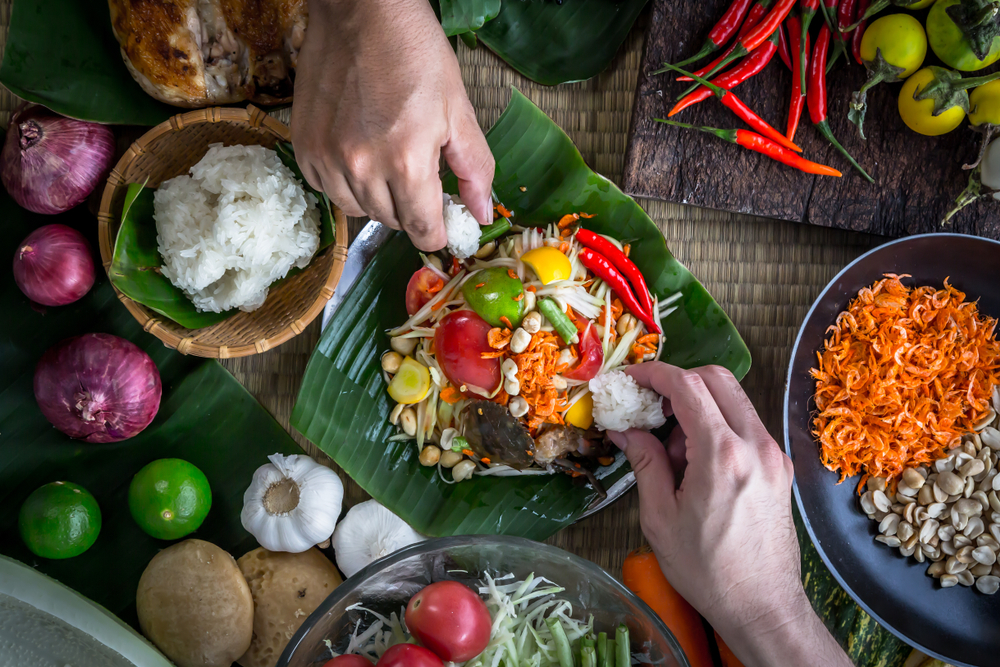
When I first landed in Thailand, I attempted to live on “burn your taste buds off” food. It was amazing and I felt like a spice rockstar, but after a couple days my stomach didn’t believe this. My stomach said to my brain, “Today, please ingest only bland crackers and milk.” But I had another solution. I decided to order the most seemingly mellow dish on the menu: papaya salad. Salad with fruit seemed safe. Don’t make this mistake. Despite the name, papaya salad is also only for spice rockstars.
Papaya salad, or som tum, is made from pounding shredded green papaya with lime juice, dried shrimp, tomato, garlic, peanuts, fish sauce, palm sugar, and often small, whole crabs. Generally, it also includes a huge helping of tiny (but explosive) chillies–bird’s eye chilies. And that’s what destroys those who order papaya salad assuming it’s a tame dish.
However, it’s an absolute must try for all, including vegetarians. Maybe this is one to try after you’ve given up spice for a day or two so your belly is prepared.
In Bangkok, head to the adorable Madame Somtum. The som tum here will set you back less than $3.
Larb
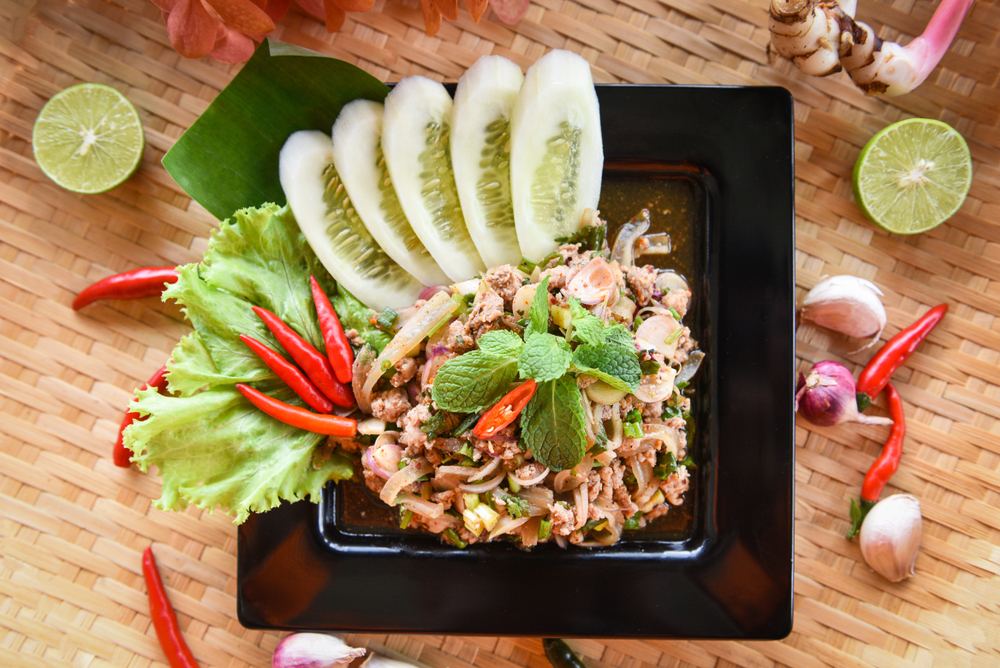
Although officially from Laos, larb is another dish that is not to be missed while in Thailand. Larb is a beautifully balanced sour spicy dish filled with the bright freshness of mint, lemongrass, and cilantro. Larb comes in many varieties, generally pork, chicken, or tofu. You take a heaping spoon of the minced dish and wrap it in a lettuce or cabbage leaf. Then delicately try to get it all in your mouth without making a fool of yourself and dropping it all over. Or go ahead and make a mess because you’ll probably never encounter any of your fellow diners again.
This dish is like eating the vegetables you grew in your garden. You know, the ones you definitely killed twice but somehow revived after giving them several motivational speeches? And then a master Thai chef turned the mint, lemongrass, and cilantro into something magical. They also added too much chili, but it’s devourable anyway. Nothing a beer can’t fix.
For vegetarians who don’t want to sacrifice flavor, tofu larb is your new best friend. Go ahead and eat it for breakfast, lunch, and dinner. For the best possible tofu larb, head to the beach town of Sairee on Koh Tao and dine at Coffee Boat Restaurant. A filling meal here is around $2 per entree.
Khao Soi
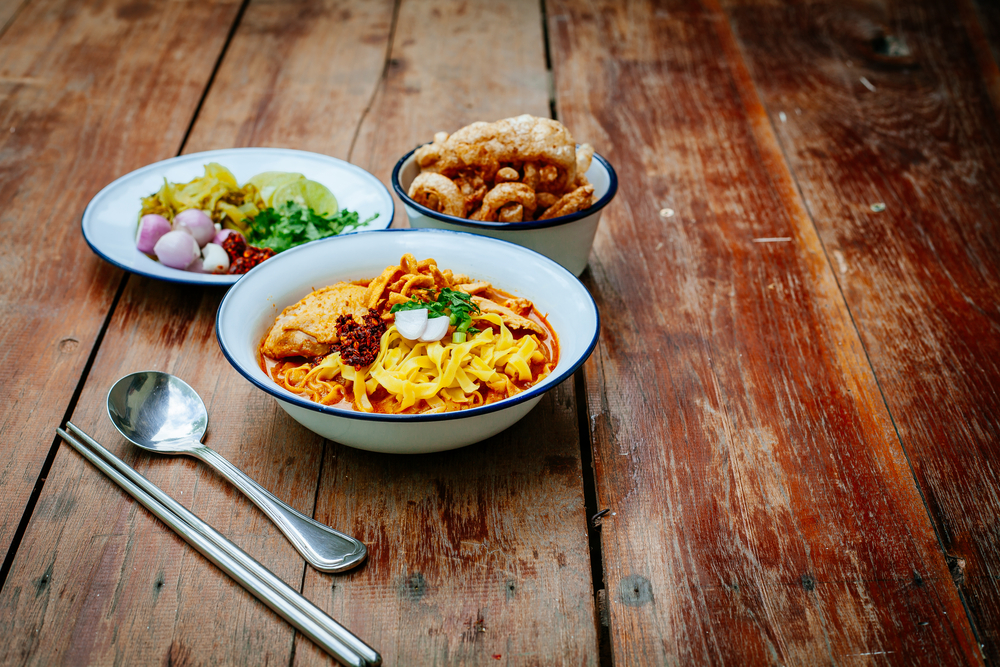
While speaking of northern Thai food, khao soi cannot be left out of the conversation. Khao soi is a staple of Chiang Mai. Not eating khao soi in northern Thailand would be like not eating at In N Out while in California. Not acceptable. The soup is a rich, deep slow-simmered coconut curry broth with tender egg noodles that is topped with beautifully crispy fried egg noodles, pickled mustard greens, chili oil, and shallots. Warning: the deep creaminess of khao soi may just keep you hunting for the best khao soi in Thailand for your entire trip. You’ll have to start using your toes to count how many bowls of this heaven you’ve devoured.
Khao soi is served with shredded chicken, but many variations, including meatless, exist. And you’ll become an instant fan of pickled mustard greens, which makes you sound like a refined health-food junkie so it’s a win-win.
In Chiang Mai, you won’t be disappointed with a steaming bowl from Khao Soi Wulai. The soup here is an affordable $1 with the option to add meat for a bit extra .
Pad Kra Pao
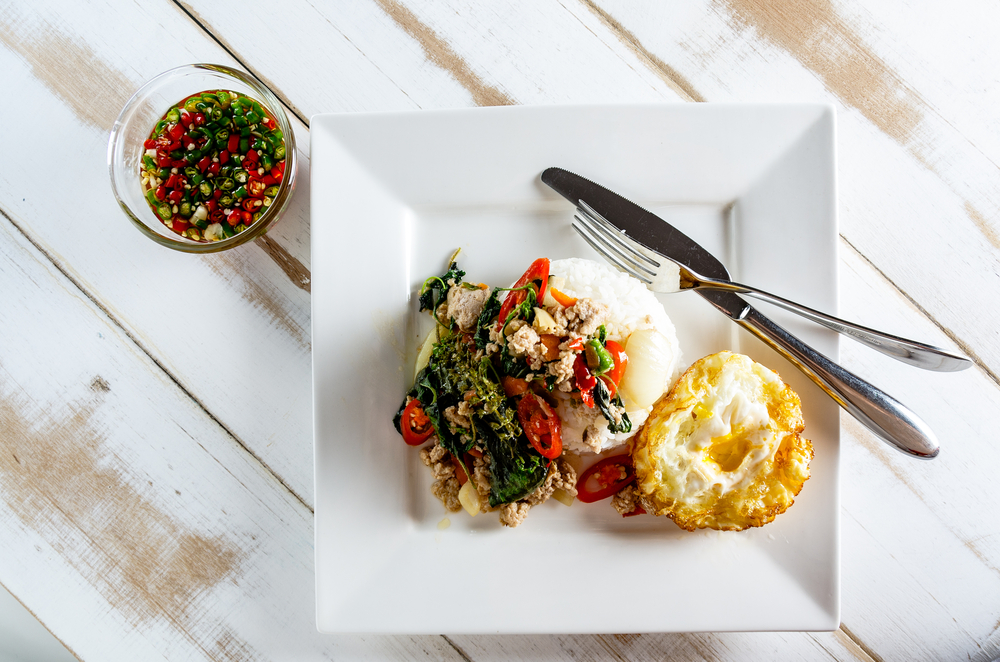
The brilliant and fiery holy basil stir fry is a street-food staple. Pad kra pao is a simple and quick dish that will knock your socks off with flavor. I lied. You won’t be wearing socks. This is Thailand, after all, and the average temperature is too hot for wearing socks. Or clothes in general, but we’re not on a French beach so please wear clothes.
Kra pao is a mixture of basil, fish sauce, chiles, and garlic. Then the Thai food masters add long beans (the taller, more handsome cousin of green beans) and ground meat, usually pork. Dump this over rice and you have a straightforward dish, but sometimes the simplest dishes are the best. Fair warning: you may walk up to the stand and physically choke on a pepper-spray cloud. This dish can reach volcanic levels of spice. If that, however, is what you are looking for, you know you’ve found the right place by the spicey plume alone. Bring tissues. But your prize is getting to tell everyone your new favorite Thai dish is kra pao, because the name is just so dang cool. And it really does punch you in the mouth and the belly.
In Bangkok, tucked down an alley near Asoke station, you can devour the best kra pao from a man who’s been perfecting it for over 47 years at Ung Jia Huad. You’ll eat here for less than $2.
Yen Ta Fo
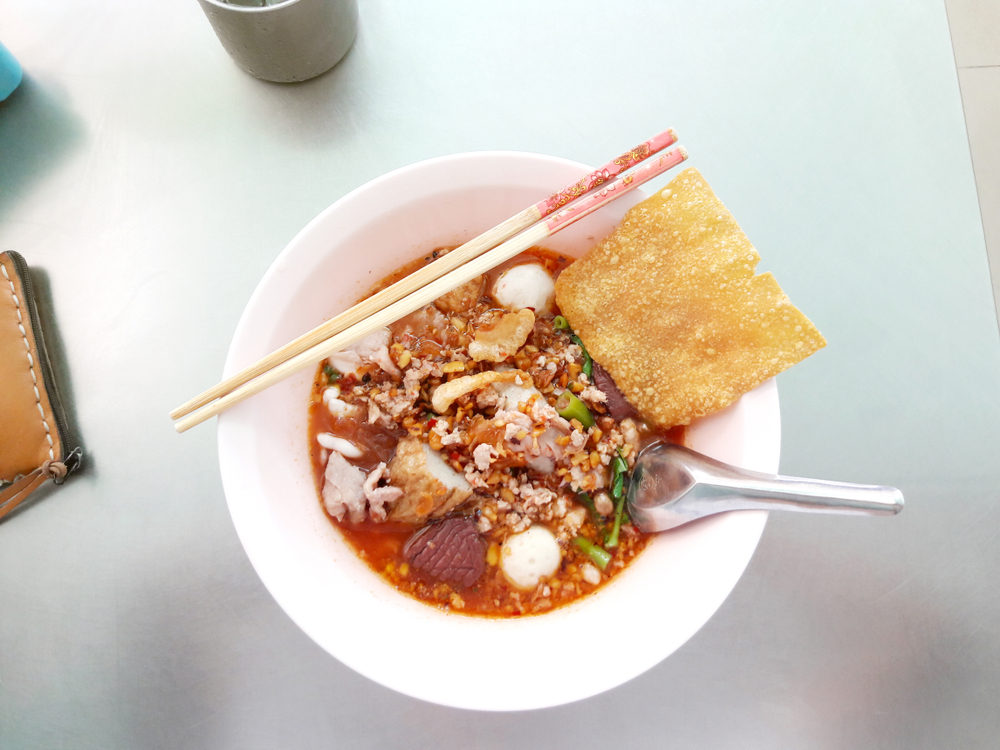
When walking the streets, keep your eyes open for the hot pink soup. It looks like coolant for your car. But this is edible coolant. Yen ta fo is a sour and sweet seafood noodle soup. It usually has a mound of varying squid balls, fish cakes, and seafood balls all piled on top of each other. Somewhere in that bowl is also a wonton sheet fried into a cracker and a couple squishy brown gelatinous cubes. The cubes are meant to test your willingness to try new things. Are you ready? During my first encounter, I opted to try the mystery cubes before I knew what they were. I found them to have a subtle flavor and were really only notable for the odd way the cube made my teeth stick together. Just what are they? Steamed cubes of blood, of course. Great for iron and a number of other minerals, but they certainly look odd and your teeth will definitely stick together momentarily, which is an unusual sensation to be cool with.
Even if you can’t get up the courage to eat the blood, don’t let it stop you from trying yen ta fo. Maramin Noodles on the outskirts of Bangkok will set you up right for the best yen ta fo with a menu that lets you customize your bowl. If you add in all the extras, your total will be $5.
Isaan Sausage
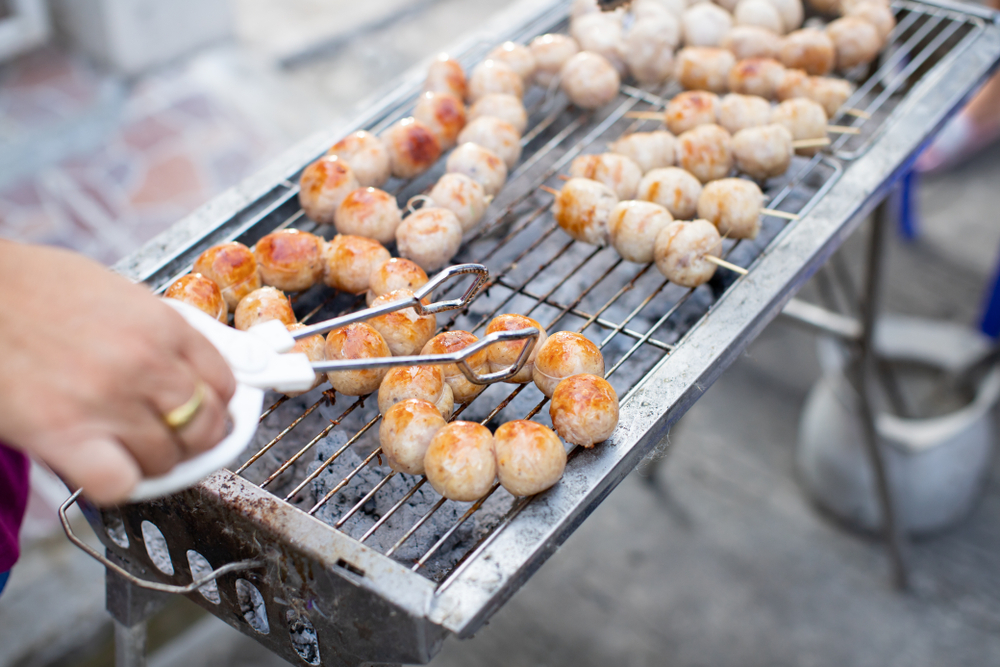
Most often found grilling along the sidewalks or in night market stands are the humble Isaan sausages. If you’re a carnivore, the Isaan sausage is a sour meat you must experience to understand. Yep, sour meat, but not because it’s gone bad. Well, it kind of has. The sour flavor comes from aging the pork. Once it’s reached its ideal fermentation, it’s combined with rice vermicelli (tiny noodles), grilled to order, and served on a stick with a bag of cabbage, slices of fresh raw ginger, and a few whole, raw bird’s eye chilis. Optional small bricks of sticky rice are generally available to make a meal out of it. Have a bite of sausage, chew on a bit of ginger, maybe a tiny nibble of chili, then a fist full of cabbage because you took too large of a bite of the tiny, seemingly harmless, chili, then head back to the sausage.
This is Thai food 101 and must be tried. After you get hooked, you’ll be looking up recipes to make this at home, which will require you to hang raw pork in your basement until it’s good and well, bad.
Being a northern specialty food, head to Warorot Market in Chiang Mai to find many food stalls specializing in the unique sausage. Most servings of sausage will be around $1-$2.
Snacks on a stick
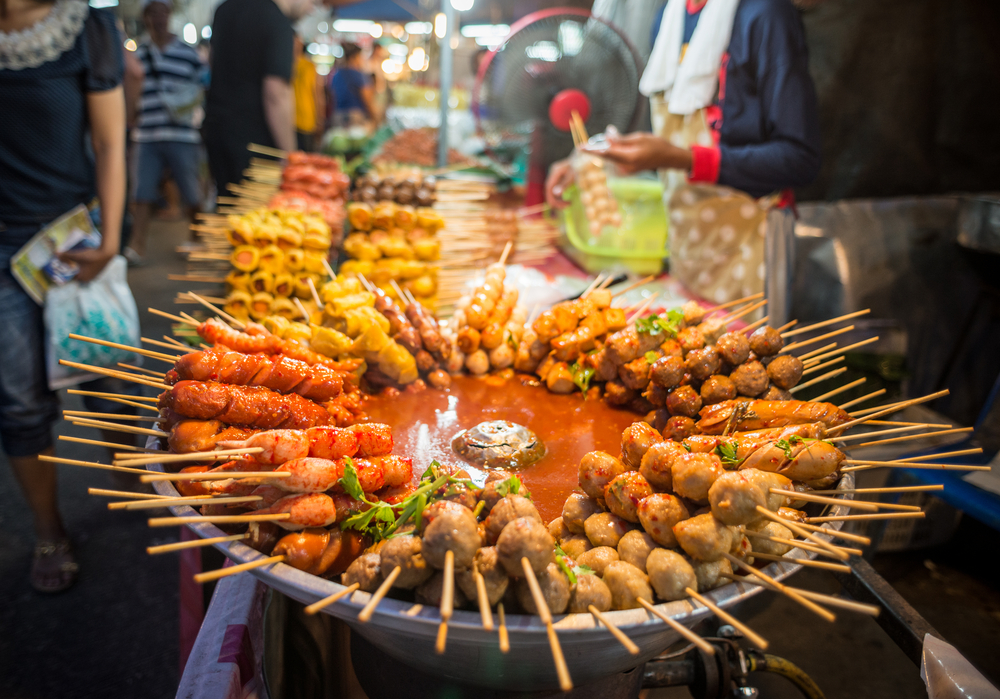
While on the subject of street food, there is almost always a stand around selling sticks of various fast-food type snacks, hot dogs, tiny cocktail sausages wrapped in fried wontons, tofu cubes, seafood patties, and various other sticks of goodness. Try out a few for fun, but seek out a hidden gem: small fried wonton purses hiding a treasure inside. Eggs from a small bird, the quail to be exact, are roughly a third the size of a standard chicken egg and are hidden inside the fried wonton. When you have picked out the sticks you would like, the vendor will pour a sauce over the top of whichever sticks you’ve chosen. Decide between either a sweet and sticky, lightly spicy chili sauce, or a darker spicier variety with no sweetness. These are the perfect snack for on the go.
You’ll find these on almost any street corner, but in case you want to eat in air conditioning, head to the basement of Siam Paragon in Bangkok to browse all food on a stick. Most sticks are around $.30 so go nuts here without hurting the budget.
Durian
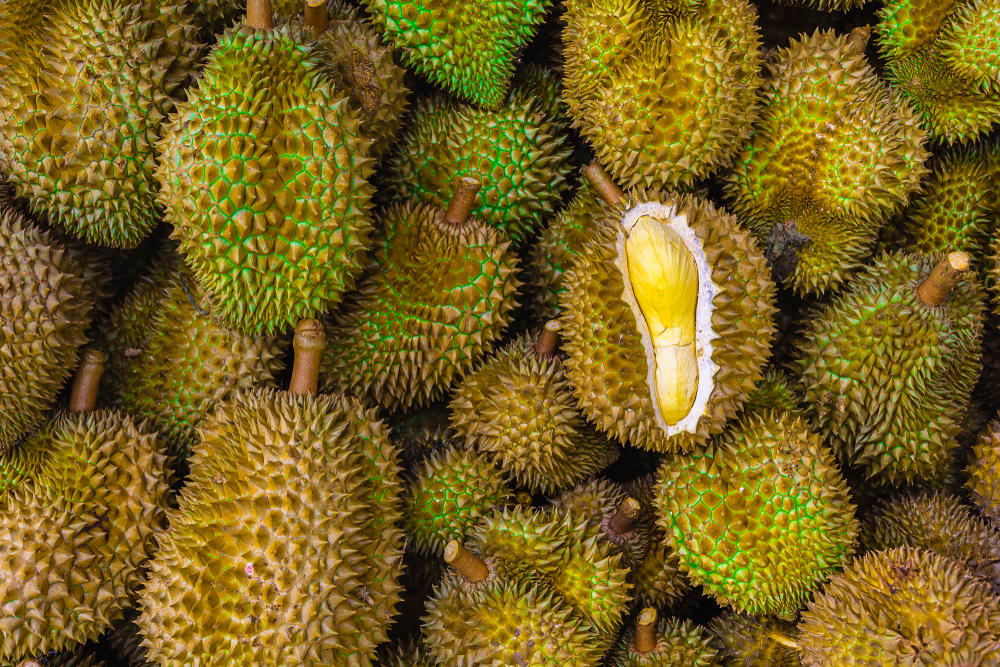
What is that horrible smell? If you have just caught a whiff that is unlike any other, but smells like: oniony garbage, gasoline, sewage, molding socks, or death itself, you may have just met the king of fruits: the durian. It’s not for everyone, but in Thailand and throughout Southeast Asia, it has earned the title “the king of fruit.” As the king of fruits, it’s not offended that it smells like molding socks. The king of fruits is so pungent that it’s banned in most hotels and on public transportation. So why would anyone want to eat such a horrible smelling fruit? Some people think it actually tastes great. A delicate, savory, creamy custard, the durian is in a realm all of its own. You just have to get past the smell, and the price. Being the king of fruits comes at a high cost as well, but for many, it is worth the negatives to taste this unique fruit.
You’ll find this fruit sold on the streets all over the country, but you can also buy it at most grocery stores. Big C grocery store is always a sure bet. While certainly not the cheapest fruit in Thailand, a heaping pile of durian will set you back around $4.
Give it a try. If you love it, please let me know. I love it, but have never found anyone else who does and therefore, I eat it alone. Sitting on a curb. Far, far away from anyone else. It’s a lonely life being a durian lover.
Mango and Durian Sticky Rice
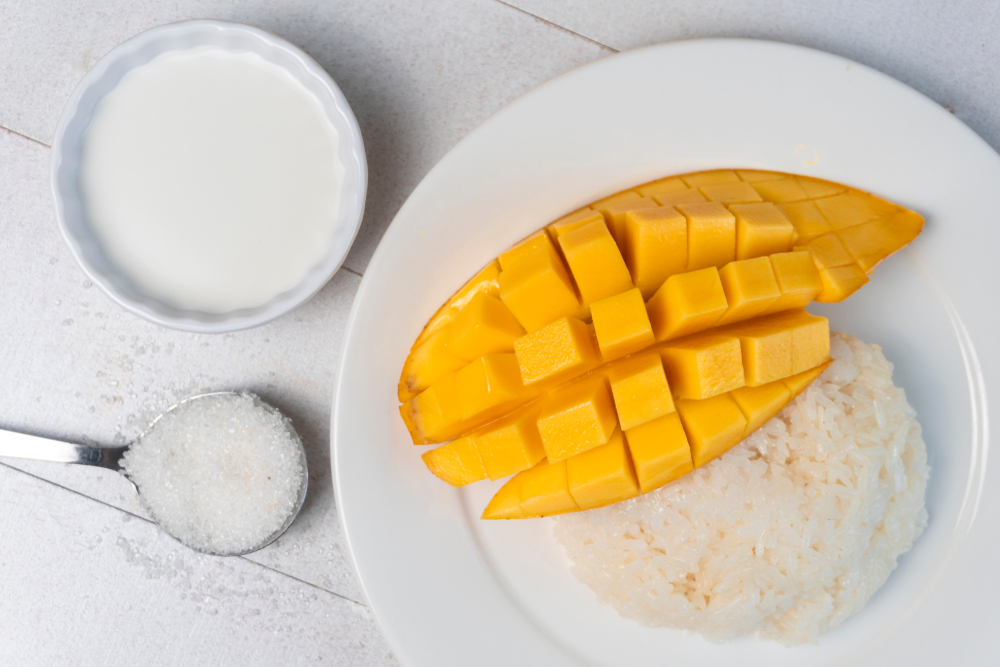
Thailand is a dessert lover’s paradise, and mango sticky rice is a major reason why. Before you leave for Thailand, add an extra mile to your run to help offset this dish that will become your favorite dish ever. Mango sticky rice is quite simply sliced mango laying on a bed of warm sticky, and often ever so slightly salty, rice that is drizzled with a sweet coconut sauce. Keep running. It’s a simple dish, but that is part of the magic because it is absolutely amazing. There is no excuse not to give it a try, unless you are allergic to mangoes (is that a thing?). If perhaps you are allergic or strangely don’t like mangoes, or you would like to try the more daring version, you can go for the durian sticky rice. It’s equally delicious, but your neighbors might hate you since you stunk the place up. Mango sticky rice is found all over the country on many street corners.
For an air conditioned experience, head to the Pier 21 food court at Terminal 21 in Bangkok. A filling plate of mango sticky rice will cost about $3. After you’re done, go running at Lumpini Park. That way you can eat another plate of mango sticky rice later. You earned it.
Krating Daeng
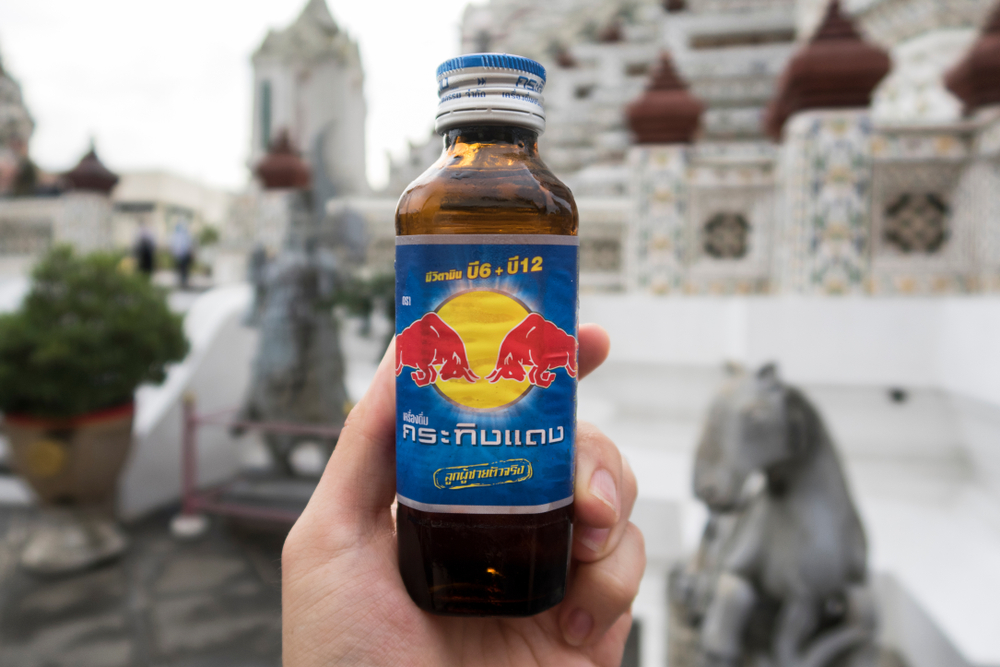
Whether jet lag has you feeling upside down, or it’s 3am and you are still at the beach, Thailand has a treat for you. Inside any convenience store you’ll find a little brown glass bottle with a label that looks suspiciously like Red Bull. No, this is not a knock-off, in fact, it’s the opposite. It’s the original. Red Bull has humble beginnings as a Thai pharmaceutical product in the form of, you guessed it, Krating Daeng. In the 80s it was reformulated and brought to the rest of the world as the Red Bull we know, but Krating Daeng is the original and pharmaceutical grade of Red Bull. Far more intense, much sweeter, and less carbonated, it will certainly do its intended job. If Krating Daeng is too syrupy or sweet for you, grab a bottle of soda water, chug some down, and pour the liquid life of Thai Bull Red into the soda water bottle.
Any 7-11 in the country will carry this magical elixir. It’s a small bottle and will set you back about $.30. Don’t be deceived by the small bottle. You definitely only need one.